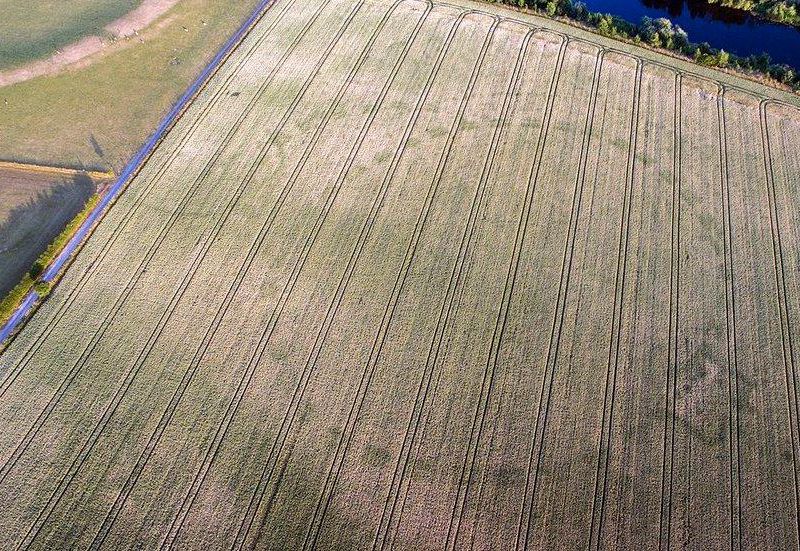JUDY WOODRUFF: Parts of Europe baked in out-of-the-ordinary warm spells this summer. But as the NewsHour's Julia Griffin reports, while uncomfortable for some, the heat revealed a treasure trove of long-lost historical landmarks.
JULIA GRIFFIN: In the United Kingdom and Ireland this summer, prolonged heat waves sent city residents in search of shade and cooling spritzes.
WOMAN: It's way too hot, and people aren't used to it.
JULIA GRIFFIN: And prompted dairy farmers to ration feed.
ABI READER, Dairy Farmer: I haven't seen the farm this dry ever. I think the last time we had a very dry period on the farm was in 1976.
JULIA GRIFFIN: But while trying for some, the British Isles' driest summer in 57 years has been a boon for local archaeologists and history buffs.
ANTHONY MURPHY, Photographer, Mythical Ireland: It's been tremendously exciting.
JULIA GRIFFIN: In July, author Anthony Murphy photographed a 5,000-year-old previously undiscovered gathering site known as a henge in Eastern Ireland.
ANTHONY MURPHY: I just simply couldn't believe what I was seeing. This was in a field of crops. So this wasn't the marks of farm machinery in the soil or anything.

JULIA GRIFFIN: Instead, the concentric rings of dots were crop marks, ghostly outlines of a civilization past emerging from the moisture-starved landscape. Crop marks and their related phenomena, parch marks, allow drone operators and aerial archaeologist to see thousands of years of history beneath the dry soil without ever having to pick up a shovel. Here's why they form. Over time, prehistoric ditches, moats and other dug-out features are filled in by subsequent generations. Today, those areas retain more water and dry spells than the surrounding earth and lead to taller and greener grasses and crops. At the same time, thin layers of soil placed over old stone walls or building foundations cause vegetation above to dry out more quickly. The result is a variety of geometric figures visible only from above.
DAMIAN GRADY, Historic England: We discovered hundreds of new sites this year spanning about 6,000 years England's history. Damian Grady is an aerial reconnaissance manager with Historic England, one of them many groups chronicling the sites for future preservation and excavation.
DAMIAN GRADY: These range from Neolithic ceremonial monuments, Iron Age, Bronze Age and Roman farms, medieval settlements in the east of England, and also World War II camps that we have not seen for a long time.
JULIA GRIFFIN: Among the group's older discoveries, a circular ditch associated with an Iron Age settlement known as a round, the enclosed fields and paddocks of a Roman era farm, and an unusual triple-ditched burial mound likely from the Bronze Age. But there have also been rediscoveries of more recent activity, like the long-gone barracks and sidewalks of a World War I prisoner of war camp in Southern Scotland, the foundations of Tixall Hall in Staffordshire, England where Mary Queen of Scots was once imprisoned, and the geometric pattern of an 1850s garden etched once again in the grounds of Gawthorpe Hall in Lancashire, England. Rising temperatures are revealing secrets across the English Channel too. In Switzerland, researchers have announced the discovery of the C-53 Dakota aircraft. It had crash-landed on a glacier in the Bernese Alps in 1946.
NARRATOR: This is the forbidding seen high up in the Bernese Overland where the now famous Dakota came down.
JULIA GRIFFIN: All 12 people aboard the U.S. Army transport plane survived the ordeal, but for five frigid days, they were forced to live only on melted snow and rationed chocolate as they awaited rescue. Newsreel footage from the time chronicled how Swiss pilots used reconnaissance planes fitted with skis to bury the passengers to safety two by two.
NARRATOR: As for the reunions, well, they certainly were good to see.
JULIA GRIFFIN: The event marks the first time the Swiss Air Force used planes for a mountain rescue. Since then, the Dakota was locked away, frozen under layers of snow and ice, until the summer, when heat waves and the glaciers' retreat revealed the wreckage once again, about two miles down from the original crash site. Archaeologists and the Swiss Air Force are working to retrieve the wreckage and hope one day to put its artifacts on display. For the PBS NewsHour, I'm Julia Griffin.












